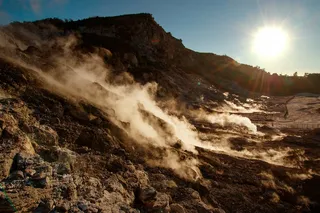Titan is a strange, strange world — a frigid moon of Saturn larger than Mercury where water is frozen rock solid and lakes of liquid methane permeate the surface. But now there's a new weird fold in the story of Titan: it's got canyons flooded with more liquid hydrocarbons. The find, announced today by NASA and published in the Geophysical Research Letters journal, details "channels" of hydrocarbons — in other words, streams of methane and other organic compounds that flow like water at low temperatures. While the canyon features were known to NASA previously, radar evidence now reveals that the features are liquid and not solid ices. The observations come from a Cassini probe encounter with Titan in May 2013. The channels flow from the giant hydrocarbon lakes into the canyons, some of which are up to 1,870 feet (570 meters) deep. However, the streams are typically less than half ...
Titan Is Home to Canyons Flooded with Methane
Discover the Titan moon canyons flooded with methane, revealing organic compounds flowing like water in a strange world.
More on Discover
Stay Curious
SubscribeTo The Magazine
Save up to 40% off the cover price when you subscribe to Discover magazine.
Subscribe












